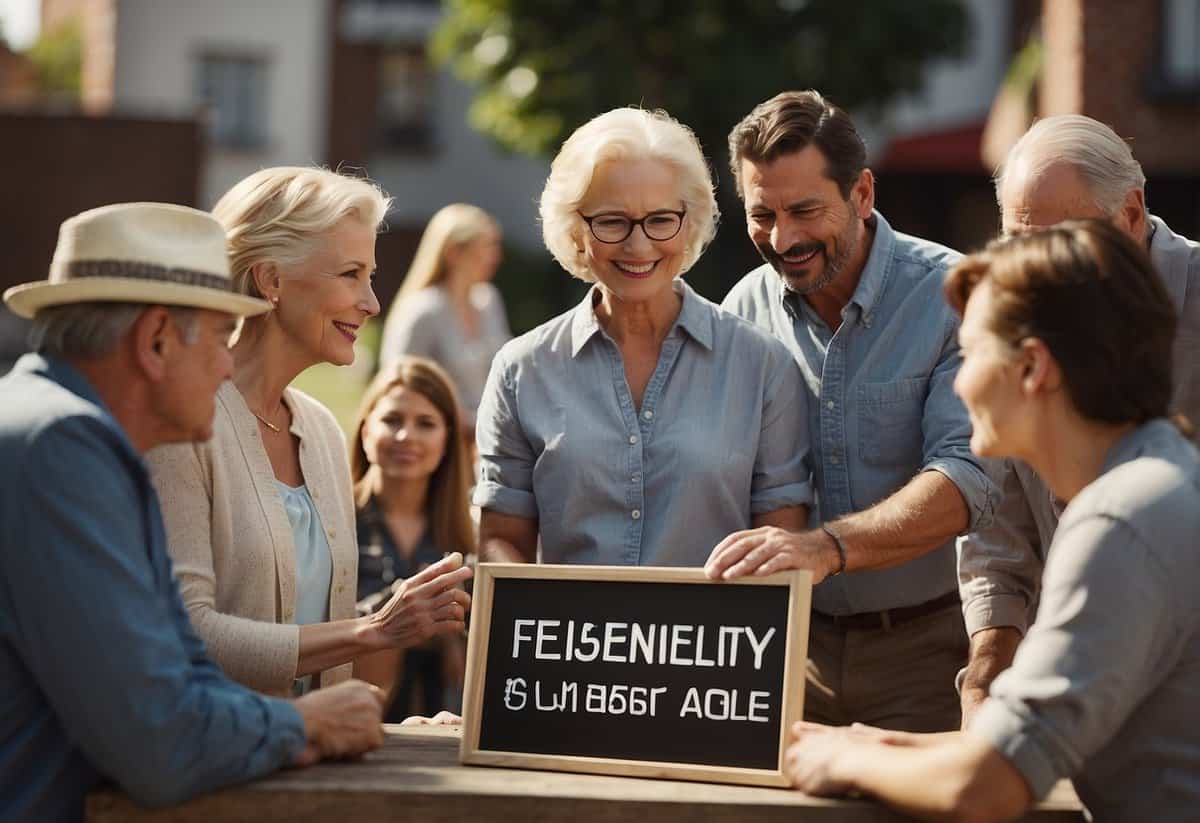What Age Do Most People Meet Their Spouse? Unpacking the Statistics
In navigating the journey of life, one of the most significant milestones often involves meeting a lifelong partner. Curiosity about the age at which this happens is common, as knowing when you might meet your spouse can be both exciting and somewhat reassuring. It turns out that the answer varies, reflecting a mix of cultural traditions, societal changes, and personal paths. Research suggests that men and women typically find their life partners at different ages, with the average woman meeting her spouse by age 25 and the average man by 28. These figures can be influenced by a myriad of factors, including changing societal norms and the shifting landscape of how couples meet in modern times.

The dynamics of dating and relationships have evolved significantly with technology playing a pivotal role. Now, the chances of meeting a significant other are no longer confined to family introductions, workplace connections, or social gatherings. Online platforms and dating apps have opened up a new realm of possibilities, allowing individuals to connect with potential partners they might not have encountered otherwise. This modern dating landscape indicates that couples also meet in less traditional settings like restaurants, through mutual friends, or even at places of worship.
Key Takeaways
- Meeting a spouse can occur at different ages, commonly in the mid to late 20s.
- Dating and relationships are influenced by various cultural and societal factors.
- The rise of online dating has diversified the ways in which partners can meet.
Demographics and Patterns in Relationships

Exploring how people meet their spouses is fascinating and varies widely based on various factors like age, gender, sexual orientation, and ethnicity. The intersections of these elements influence relationship dynamics significantly.
Average Age of Meeting a Spouse
You might be curious about when you’re most likely to meet your future spouse. Historically, the average age for meeting one’s spouse varies, but studies show that it’s typically in the late 20s to early 30s. Recent trends, however, indicate a shift towards later ages as many prioritize education and career development before settling down.
Influence of Gender and Sexual Orientation on Relationships
Your gender and sexual orientation play a substantial role in the relationship dynamics. For instance, men and women often experience different societal pressures and expectations, which can affect when and how they form partnerships. Additionally, daters in the LGB (lesbian, gay, bisexual) community are more likely to meet partners online compared to their heterosexual counterparts. This trend showcases the importance of inclusive digital spaces that cater to diverse sexual orientations.
Effect of Ethnicity and Race on Spousal Meeting Age
Your ethnicity and race can also influence the age at which you meet your spouse. Those belonging to different races or ethnicities might find varied patterns based on cultural traditions, family expectations, and social networks. For instance, in some cultures, there is a stronger emphasis on early marriage, while others may experience a broader age range for meeting their life partners.
Modern Dating Landscape

In your search for companionship, it’s likely you’ve noticed the dramatic influence that online dating platforms have on the way relationships begin today. Factors such as the convenience of dating apps and altering societal norms around dating have reshaped the playing field significantly.
Impact of Online Dating Platforms
Dating app usage has skyrocketed, creating a profound impact on how you meet your potential spouse. The Pew Research Center survey indicates that online dating has gained substantial popularity, with around 30% of U.S. adults reporting having used a dating app or website. This trend is even more pronounced among millennials, suggesting that these platforms could play a key role in how your generation meets their significant others.
Popular apps such as Tinder, Match.com, Hinge, and Bumble have diversified the ways in which you can connect with potential partners. Given these tools, you’re able to refine your search for a spouse with criteria that are important to you, ranging from interests to lifestyle choices. It’s noted that a sizable percentage of relationships and successful marriages began online, emphasizing the efficacy of these services in facilitating long-term connections.
Shifts in Dating Norms and Expectations
Your expectations and the norms around dating have also transformed alongside the rise of online dating. With the increase in app usage, you might find that the stigma once associated with meeting someone online has dissipated. In contrast to previous generations where meeting a spouse through family or friends was more common, it is now not unusual for relationships to start in the digital realm. The U.S. Census Bureau data reflects this shift, illustrating changes in marriage patterns and ages.
Furthermore, dating statistics point to a change in what you may seek in relationships. With more opportunities to meet diverse individuals, you’re more likely to prioritize compatibility and personal fulfillment over more traditional motivations such as financial security or family arrangements.
By understanding these facets of the modern dating landscape, you can navigate the search for your spouse with a clearer perspective on where and how these meaningful connections are often forged.
Cultural and Societal Influences

Your journey to finding a lifelong partner can be deeply affected by the society you live in and the cultural practices you follow. From the influence of your upbringing to the societal norms that guide your daily life, these factors contribute to when and how you might meet your spouse.
Role of Family and Education
Family: Your family often plays a pivotal role in your path to matrimony. In America, it’s not uncommon for parents to introduce their children to potential partners, hoping to influence the decision. This can sometimes lead to arranged meetings or even weddings that honor longstanding traditions.
Education: It also significantly impacts your dating life. Higher education provides more opportunities for meeting people, yet it can also lead to increased debt, which some Americans consider when deciding to settle down. Balancing the desire for love and the practicality of financial stability is a common challenge you might face.
Societal Expectations and Lifestyle Choices
Societal Expectations: In the United States, societal norms often encourage you to pursue marriage as a marker of adulthood. Traditional milestones, like finishing your education, getting a good job, and then marrying, still hold sway over many. However, lifestyle choices have shifted. With the rise of the #metoo movement, you might find that casual dates are approached more carefully, with respect and consent taking center stage in your dating lives.
Lifestyle Choices: Choosing to live in a bustling metropolis like New York City or opting for a quieter life elsewhere can influence when you meet your spouse. City life often means a faster pace and delayed marriage as you juggle career ambitions and social experiences. Moreover, with politics and current events influencing societal expectations, you might feel pressured to find a partner who shares your world view, adding another layer of complexity to your nuptial quest.
Relationship Milestones and Their Timing

Navigating the journey of a romantic relationship involves a series of milestones that can often be mapped out from the first hello to a committed partnership. Understanding when these milestones typically occur can help you gauge the progress of your own relationship.
From First Contact to Committed Relationship
In the dance of love, the first steps are often critical. It usually starts with holding hands, an intimate gesture that signifies a connection beyond mere friendship. Then comes the first kiss, an electrifying moment that deepens the bond between two people. Surveys suggest that the average woman is likely to meet the one at around 25, while the average man might find his life partner closer to 28. This timeline can vary greatly, though, and it is not uncommon for it to happen earlier or later in one’s twenties.
- Hold hands: Signals the beginning of a physical connection.
- First kiss: Often marks the start of a romantic relationship.
- Say “I love you”: A declaration that typically signifies a transition to a more serious commitment.
A committed relationship usually solidifies once you’ve both voiced those three little words: “I love you.” An expression of deep affection, it’s the leap from enjoying each other’s company to considering a future together.
Long-term Trends and Relationship Duration
The duration and outcome of relationships can hinge on a multitude of factors, and these relationships often follow certain trends. Despite the fear of break-ups, most couples venture into relationships with hope. According to relationship success rates, timing can be a critical element for whether a couple stays the course or parts ways.
- Years together: Longevity in relationships can be an indicator of compatibility and shared values.
- Break-ups: A natural, if painful, part of many relationship trajectories; often a step towards finding a more compatible partner.
A survey data indicates that beyond the exciting milestones of hand-holding, kissing, and declarations of love, the success of a long-term union often aligns with where both individuals are in their lives and how ready they feel to commit to a committed relationship.
Frequently Asked Questions

When it comes to understanding romantic relationships, you might have some questions about the timing and circumstances in which people typically find their life partners. These FAQs address common curiosities about age, setting, and factors impacting the meeting of spouses.
At what age do individuals typically encounter their future husband or wife?
Research suggests that women, on average, meet their life partner around the age of 25, while men are more likely to meet their significant other at the age of 28. This is based on general patterns and may vary widely by individual circumstances. When will I meet the one? Science says this is the age – Marie Claire UK
Are most couples likely to have met during their college years?
Many couples do meet during their college years; however, a larger percentage meet through mutual friends, at work, or online. College can be a significant meeting place, yet it is not the majority setting for couples to first connect. 23 Where Do Couples Meet Statistics (And What They Mean)
What’s the probability of having met your life partner by a certain age?
Studies indicate that by the age of 30, many people have likely encountered a partner for a long-term relationship. However, these findings also reflect that there’s still a considerable chance for individuals to meet partners beyond this age.
How common is it for people to be single in their thirties?
It’s increasingly common to be single into your thirties. Societal changes and shifting priorities mean that many people are focusing on career, travel, or personal growth during their twenties and early thirties.
What is the prevalence of meeting your soulmate at a young age?
While some people meet their soulmate at a young age, it’s more of an exception than the norm. Most individuals go through several relationships before finding a long-term partner, with many encountering their significant other in the latter part of their twenties.
What factors contribute to the success of long-term relationships without giving away any secrets?
Success in long-term relationships often comes down to mutual respect, communication, shared values, and the ability to grow together. The strength of the bond between partners is enhanced when they actively work on their relationship and adapt to life’s changes together.

